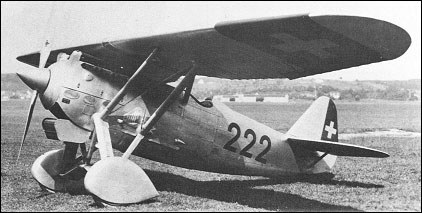|
| The design that took Emile Dewoitine's parasol fighter
formula to the apex of its development was the D 27,
which was evolved to meet the requirements of the
STAe 1926 C1 leger programme for lightweight fighters. Adhering closely to the structural concept of
preceding fighters, but embodying much aerodynamic
refinement and a split-axle (with independently articulated
wheels) rather than cross-axle undercarriage, the
D 27 was powered by the 500hp Hispano-Suiza 12Mb
(HS 57) 12-cylinder Vee engine and had an armament of
two synchronised 7.7mm guns. The liquidation of the
Construction Aeronautique E Dewoitine in January
1927 resulted in the transfer of development of the D 27
to the EKW in Switzerland, where a prototype flew on 3
June 1928. By the end of the year, three had been
ordered by Romania, one by Argentina and three by
Yugoslavia (of which two were to be delivered as
assemblies for completion by Zmaj at Zemun), and the
prototype was undergoing evaluation by the Swiss
Fliegertruppe in competition with Alfred Comte's AC-1.
In the autumn of 1928, the EKW initiated a pre-series of
12 D 27 fighters, these adopting a redesigned tail and a
revised wing of 0.45m2 less area, modifications
first tested in the Laboratoire Eiffel wind tunnel.
Meanwhile, in March 1928, Emile Dewoitine had reestablished
himself in France, forming the Societe
Aeronautique Francaise-Avions Dewoitine. The
second and third pre-series D 27s were delivered to
France in April 1929, the former being re-engined with
the 400hp HS 12Jb as the D 272 for aerobatic demonstrations,
and the latter undergoing STAe evaluation at
Villacoublay from 28 May equipped with two 7.7mm
Darne guns. On 29 November 1929, a contract was
issued by France's DGT (Direction Generale Technique)
of the Ministere de l'Air for the second and third
pre-series aircraft plus three (later increased to four)
additional fighters to be assembled by Liore-et-Olivier. The D 27 was offered to the Forces Aeriennes Terrestres
as the D 271 with the 500hp HS 12Hb engine
and as the D 273 with a Gnome-Rhone Jupiter VII with a
compressor enabling 425hp to be delivered at 4000m, but neither model was adopted. At the end of
1929, however, the decision was taken in principle to
re-equip the fighter element of the Swiss Fliegertruppe
with the D 27, a pre-series of five being ordered from
the EKW as D 27 Ills, with deliveries commencing in
1931. A pre-production batch of 15 followed, additional
contracts being placed for 45 D 27 Ills to bring deliveries
to the Fliegertruppe to 66 (including the prototype).
These remained first-line fighter equipment until
1940, when they were relegated to tuitional tasks,
being finally scrapped in 1944.
 | A three-view drawing (640 x 444) |
| MODEL | Swiss D 27 III |
| WEIGHTS |
| Take-off weight | 1415 kg | 3120 lb |
| Empty weight | 1038 kg | 2288 lb |
| DIMENSIONS |
| Wingspan | 10.30 m | 34 ft 10 in |
| Length | 6.56 m | 22 ft 6 in |
| Height | 2.78 m | 9 ft 1 in |
| Wing area | 17.55 m2 | 188.91 sq ft |
| PERFORMANCE |
| Max. speed | 298 km/h | 185 mph |
| Range | 425 km | 264 miles |
|
Do you have any comments?
|
| 
COMPANY
PROFILE
All the World's Rotorcraft
|







